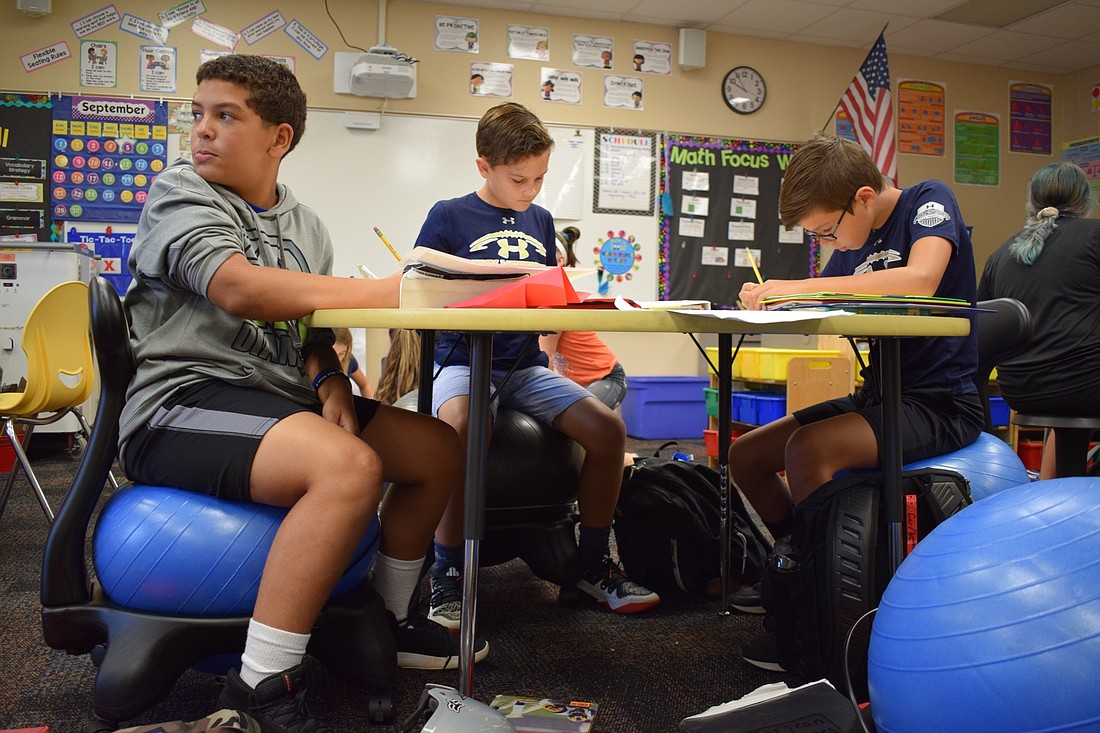- April 8, 2025
-
-
Loading

Loading

When Gilbert W. McNeal Elementary School fifth-graders walk into teacher Alice Lander’s classroom, they have a choice to make.
Where are they going to sit?
A few factors play into each student’s decision, but most importantly, they have to decide what they’re going to sit on.
Gone are the days of students spending seven hours per day sitting on hard, plastic chairs as more teachers are using flexible seating, which provides students an alternative in their classrooms.
In Lander’s class, students have multiple options from exercise balls to wobble stools to even the floor.
Fifth-grader Brooke Meyers prefers to sit on an a wobble stool in class so she can fidget while working.
“I’m a fidgety person, and when I’m in a yellow (hard plastic) chair, I can’t really move around, so I’m more focused on how uncomfortable I am,” said Meyers, who is 10. “But these are all comfortable, and you can move around while writing. It’s just great. In the yellow chairs, you’re just stiff.”
Lander’s classroom is one of many at McNeal Elementary that have incorporated flexible seating as well as teachers at Tara and B.D. Gullett elementary schools.
McNeal Fourth-grade teacher Ashlie Fulmer and third-grade teacher Xiomara Cappiello have also been transforming their classes to include more flexible seating because they’ve noticed their students focus more when they are comfortable compared to the traditional yellow chairs used at the school.
“As long as they can stay focused and comfortable, I can teach, and that’s the goal,” Fulmer said. “We have a lot of kids that a traditional anything doesn’t work. As teachers we’re always asking, 'what can do we different?”
According to a 2017 study from California State University San Marcos, students’ work was neater, students paid more attention to detail and fewer reminders to stay on task were given as a result of flexible seating.
“I can see some of the wiggly kids, instead of falling out of their chair or being disruptive, will pick a wobble stool or an exercise ball, and it allows them to get some of their wiggles out but still be able to sit and focus,” Lander said.
Brandy Bellittera, a kindergarten teacher at B.D. Gullett Elementary, said her 7-year-old daughter, Delaney, who is autistic, "helped me really kind of change the way I see and do things in my classroom."
"When you first start out teaching, you probably think traditional, that every kid should have a name tag and a seat and that's where they sit every single day all day," Bellittera said. "And with having her, she functions so differently with autism than anybody else does that she may not have that ability to sit in that chair in that spot all day long even with transitions in between."
As Bellittera found that her daughter could remain engaged in her school work while sitting in different areas of her house, Bellittera thought about her students in the classroom.
"As long as she's staying engaged and working, to me, it shouldn't matter where she sits," Bellittera said. "A lot of these kids are not cut from the same cookie cutter, so this kiddo may need that flexibility to stretch out because that may be what they need for their body."
McNeal Elementary Principal Cheryl McGrew said those seating options gives students the power of choice.
Meyers said students can choose to sit next to who they think they would work best with or closer to the board in the front of the class if they need to see or hear the teacher better.
McGrew said flexible seating also provides more opportunity for movement during class as students bounce, wobble and rock.
Fifth-grader Paul Jordan said he was excited for the different seating options because he’s “tired of just sitting in seats.” He likes the exercise balls “because they’re bouncy, and you can move around on them.”
Flexible seating also provides chances for collaboration because the seating options are easy to move around.
“It really helps provide the best learning environment for all children without them feeling unusual or different,” McGrew said.
Lander said the only challenge she’s faced with flexible seating comes from students being able to pick their own seat. Sometimes she must reiterate the rules and help students make good choices, like possibly not sitting next to their best friends.
“I only occasionally have to step in and guide them in the right direction,” she said. “They usually make good choices for themselves.”
Flexible seating can be expensive as some items, such as a wobble stools, can cost around $50. Many teachers — like Fulmer, Lander and Cappiello — choose to use Donors Choose, a website where teachers can post projects and ask for donations.
Cappiello said she’s also hunted for items at garage sales and thrift stores and also snatches some when there are sales at stores like Target or Walmart. She has crates with cushions on them, a couch and other items as options in her classroom.
Every summer, Bellittera chooses an area of her classroom she would like to improve.
"It's just kind of piecing it together little by little," she said. "It was not a one-year thing. It was kind of gradual with collecting furniture."